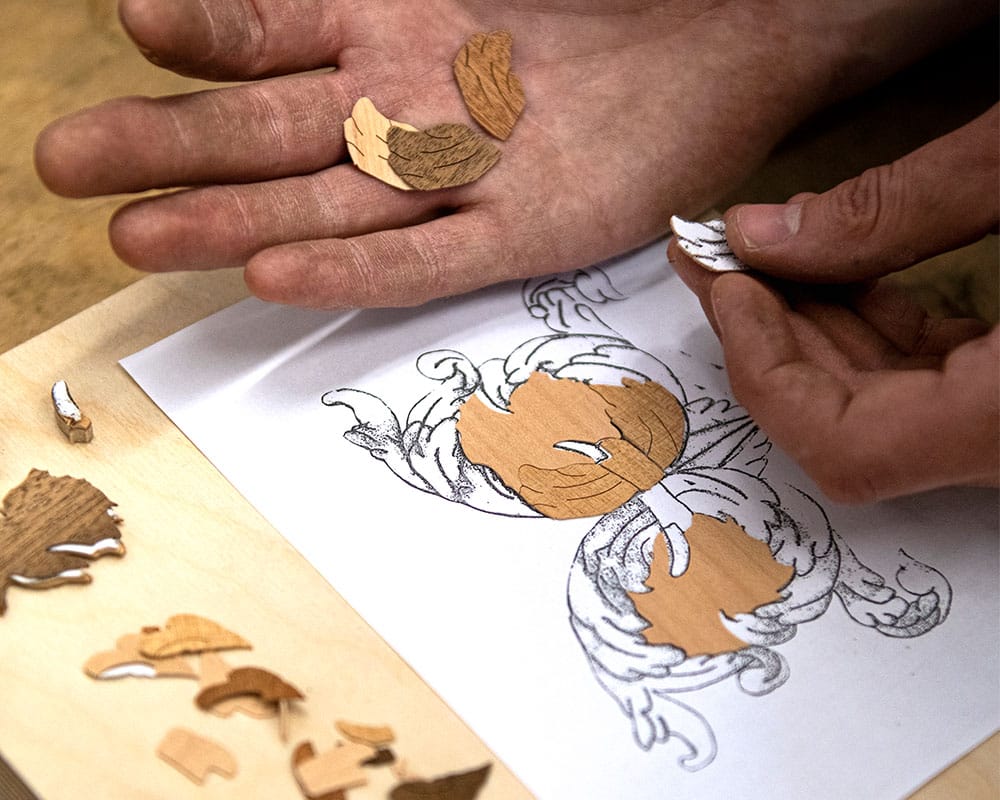Towards the end of 2019, Period Living Magazine visited our Furniture Restoration Workshop in South London to discuss Marquetry…
Interview taken from the January 2020 issue of Period Living | Text Karen Bray (additional text Alison Eltham)
We visit the studio of specialist antique restorers and conservators Plowden & Smith, to find out more about the craft and intricate skill of marquetry.
At the Plowden & Smith workshop in south London, Oliver White is among the team of specialist restorers and conservators who breathe new life into damaged antique pieces.
Among the recent marquetry projects was the restoration of a fire-damaged 17th-century longcase clock. Here, Oliver shares some of his knowledge and expertise.
What does marquetry restoration involve?
Marquetry is effectively painting in wood – using coloured veneers or decorative graining to construct patterns or pictures.
It’s quite an artistic process, so is open to artistic licence; however, as a restorer you’ve also got to be able to replicate someone else’s hand skills.
You need good hand-eye co-ordination to be able to cut out the intricate patterns. Patience is important, too, as you can’t rush the process.
If your focus is on restoring historic marquetry then a good understanding of different stylistic periods is helpful – you may need to research similar historical pieces in order to be able to produce an accurate design.
Marquetry is just one of the skills needed by furniture restorers, and in the UK is usually taught as part of furniture restoration training. However, it is an important skill if you want to restore the widest possible range of pieces.

Oliver designing the replacement section of marquetry in the Furniture Restoration workshop at Plowden & Smith. Photographs © Period Living realhomes.com/period-living / photographer Polly Eltes
What skills does marquetry call on?
You first need to identify the species of wood that had originally been used, as the figuring and colour differs vastly between types of timbers. This can be quite difficult to gauge when attempting to copy antique marquetry because the antique wood might have been stained at the time of construction, and since then will certainly have altered in appearance.
You then need to assemble the veneers in a pack, sandwiching layers on top of each other, and paying particular attention to which direction the wood grain is running on each veneer as you don’t want them running the same way.
The design is usually drawn on paper and applied to the top layer of the veneer pack, which is then pinned together to keep everything in place.
The design is pierced out with a fine-bladed saw, a careful process. It’s important to keep the blade at a 90-degree angle to the veneers to ensure that all the pieces fit accurately together. As each separate element is cut out, it’s helpful to place them in position to keep track of their location.
At this stage, you need to decide if any sand shading is required. Sand shading is the process whereby the veneers are dipped into heated silver sand to scorch the surface of the timber, and give it more depth and tone. This should eventually give the picture a three-dimensional look.
The elements are then ready to be assembled into a pattern and bonded. The top layer is sanded or scraped to achieve a flat surface. The surface is then sealed, which can be done using shellac and the decorative process of French polishing- the more layers that are applied, the higher level of sheen the finished piece will acquire.


The design is applied to the top layer of the veneer pack and pierced out with a fine-bladed saw. Photographs © Period Living realhomes.com/period-living / photographer Polly Eltes
What complexities or difficulties can it entail?
There are some species of wood that are now protected by CITES (the Convention on International Trade in Endangered Species of Wild Fauna and Flora). In instances where certain timbers, for example rosewood, cannot be used, you would need to find a suitable alternative – this means a wood with a similar grain that can be coloured to replicate the original.

The process of sand shading. Photographs © Period Living realhomes.com/period-living / photographer Polly Eltes
What was particularly interesting about the restoration of the 17th-century longcase clock?
I enjoy working on pieces from this period, and this project involved a wide range of different restoration processes. The clock had been in a house fire, therefore it needed more than just a restored marquetry section. The severely smoke, fire and water-damaged veneer needed to be completely revived. The water had penetrated the surface and compromised the glue that bonds the veneers to the carcass. It was satisfying to dramatically improve this much-loved piece’s appearance.


The bottom section of the 17th Century longcase clock showing the unsympathetic later-added plinth base (left), and the same section with its new replacement panel of marquetry (right)
Why is it important to retain these types of skills?
A lot of furniture conservation and restoration courses have closed down in the past 10 years and this has highlighted just how vulnerable some of these traditional skills are. Lots of pieces of furniture or objects feature marquetry – with some craftspeople still using this technique today – and therefore if these heirlooms are to be properly restored for future generations, it requires people with the knowledge and skill set to do that.

Interview published in the January 2020 issue of Period Living
To find out more about Plowden & Smith’s marquetry and other furniture restoration services, please visit our Furniture Restoration page, or email info@plowden-smith.com

